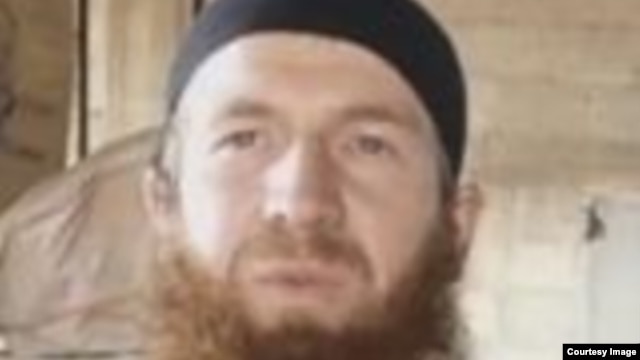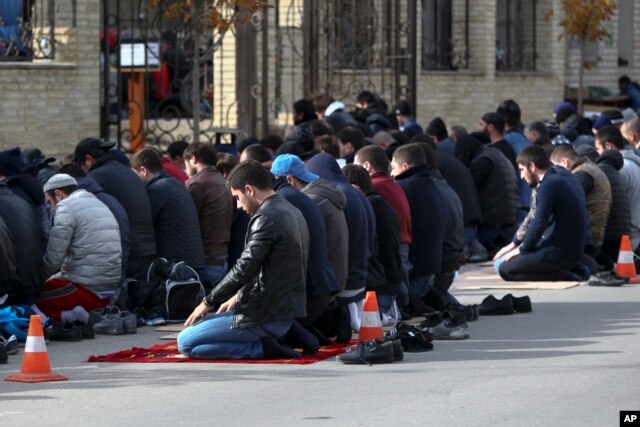IS 'Cyrillic Jihadists' Create Their Own Community in Syria
IS 'Cyrillic Jihadists' Create Their Own Community in Syria
FILE - Tarkhan Batirashvili – known by his aliases ‘Omar al-Shishani’ and 'Omar the Chechen' – is one of the most senior Islamic State military commanders and a former sergeant in the Georgian Army. The U.S. is trying to determine if an airstrike last week in Syria killed him.
March 30, 2016 2:03 PM
Over 5,000 jihadists from the Central Asian countries of Kazakhstan, Kyrgyzstan, Tajikistan, Turkmenistan, and Uzbekistan are fighting in the ranks of the so-called Islamic State militant group in the Middle East. These Russian-speaking Muslims not only play a major role within the IS leadership, but also have built a community of their own in the areas controlled by the extremist group. In fact, they are now raising their children to be a second generation of jihadists, sources say.
Russian-speaking Jihadists are the second largest group of foreigners fighting for IS. The number of jihadists from Central Asia and Russia joining IS has increased by as much as 300 percent since June 2014, according to a report by the New York City-based Soufan Group.
While their rituals, customs, race, and ethnic background may vary, members of this group have at least one thing in common that distinguishes them from other jihadists: they can read and write fluently in Cyrillic script, given that the now-independent countries of their birth were for decades dominated by the Soviet Union, which used Russian as its lingua franca.
Most of these so-called “Cyrillic Jihadists” have settled near the Syrian city of Raqqa, the de facto IS capital, and their areas have developed into real communities with certain habits and rituals. Residents can hear Friday prayers in Russian at the Abubakr Dagestani mosque. Adults can attend at the Abu Muslim Islamic school to study Arabic and Quranic thought. Children study math and the Quran at a Russian-language school run by the foreign fighter brigade headed by Abu Hanif Jamaat, a native of Dagestan in Russia’s North Caucasus region. Homesick wives of the jihadists can shop for products from their home countries at the “Univermag” Russian store.
“The Russian-speaking jihadists formed a community of their own within IS,” said Salem al-Hammoud, a civic activist from the IS-controlled Syrian city of Deir Ezzor who is currently based in Turkey. IS has fighters from all over the world, including North Africa and Europe, “but there’s a significant percentage that comes from the former Soviet republics,” he said.
“These fighters are very different from others in terms of discipline and military training comparing to their Arab and African counterparts,” Al-Hammoud said, adding that the IS leadership appoints them to important posts “because they are tough and they do not sympathize with locals.” Since they do not mingle with other jihadists, he said, IS leaders view them as “a very reliable, resilient force.”
Fighters from the Caucasus region, Central Asia and Russia are linked by their knowledge of Russian. “There is evidence that the Russian-speaking fighters train together,” said Edward Lemon, a researcher at the University of Exeter in Britain. ”Russian-speaking fighters, most notably the late Abu Omar al-Shishani, have risen to the top of the ranks of IS. Given their combat experience, fighters from the North Caucasus are regarded as particularly strong fighters.”
Abu Omar al-Shishani, born Tarkhan Batirashvili, was an ethnic Chechen from Georgia who served in the Georgian Army during its brief war against Russia in 2008 before becoming a top IS commander in Syria. He died from wounds sustained in a U.S. airstrike conducted in Syria in early March.
Not mercenaries
Contrary to the common belief that these fighters joined IS to make money, many of them see IS-controlled territory in Syria as their home and do not consider themselves mercenaries.
Babajon Karabayev, a former IS fighter who returned to Tajikistan, said that these fighters call the Islamic State home. Karabayev was looking for a job in Russia due to the bad economy in his home country. Frustrated with the Russian job market, he fell into the IS recruiting network. “Many fight for money, but most are there for their ideology,” he said. He received some money, but left the group because he was not as steadfast in his convictions as others.
In this photo taken Friday, Nov. 13, 2015, men attend a Friday prayer at the mosque on Kotrova street in Dagestan's regional capital Makhachkala, Russia. An epidemic of recruitment for the Islamic State group has swept through the predominantly Muslim parts of Russia.
A tax-free income stream is an incentive to join IS, but not enough to keep someone in its ranks over the longer term. “IS propaganda stresses the positives of living in the Caliphate - brotherhood among fellow Muslims and the idea of building a pure Islamic State,” said Lemon. “There is limited evidence that money is a driver for recruitment, but it certainly plays some role.”
IS recruiters exploit the lack of social support for Central Asian immigrants in Russia. “Many are recruited from migrant worker communities in Russia, as the lack of a supportive community there opens the door to recruitment,” says Catherine Putz, a U.S.-based journalist and researcher. “There are also economic factors involved, as extremist groups often tempt recruits with promises of money.”
Identity crisis
The fact that people like Abu Omar al-Shishani and Gulmurod Halimov, a U.S.-trained police colonel in Tajikistan who went to the Middle East and joined Islamic State, have become top IS members has created a sense of belonging for Russian-speaking Muslims, who suffered an identity crisis in their home countries. According to the Soufan Group, a majority of the “Cyrillic Jihadists” come the North Caucasus — particularly Chechnya and Dagestan, areas with long histories of Islamic extremism.
Rashot Kamalov, the imam of the Al-Sarahsiy Mosque in Kyrgyzstan who encouraged his followers to join IS in Syria, was sentenced to a five-year jail term for “inciting religious hatred” and “possessing extremist materials” in February 2015.
But Kamalov remains popular with some young Kyrgyz Muslims.
“Not only Kyrgyz but other youngsters with Islamic tendencies from Chechnya, Dagestan, Tajikistan, and Uzbekistan have been exposed to this idea and have embraced it as a form of self-expression,” says Noah Tucker, managing director of Registan.net, a website the focuses on Central Asia, the Caucasus, and South Asia. “They come to believe that the Islamic State is the Islamic utopia they were chasing for years. Most of the recruiting material from ISIS aimed at Central Asians in Russia actually focuses almost exclusively on identity – ‘You are Muslims, and your problems are caused by those who oppress Muslims’ - and offers it both as an explanation for what potential recruits have suffered in life and as a solution …, presenting ISIS as the ‘Muslim counterforce’ to this oppression.”
Islamic utopia, Russian style
Although Russia has clearly sided with President Bashar al-Assad in what it calls “the fight against terrorists in Syria,” some observers claim thatRussian authorities have encouraged local jihadists to depart for Syria. Nadir Medetov, a 32-year-old Dagestani Salafist who was arrested by the Russian security services in October 2014 on charges of illegally possessing illegal firearms turned up in Syria four months later. Some experts believe that Medetov was able to escape to Syria not due to a lapse in security, but because of a deliberate Kremlin strategy to send the most troublesome members of society to hotspots abroad.
“There are reports arguing that the Russian government took a very active role in helping jihadists and potential militants leave the Caucasus to go fight in Syria - where, as it turned out, the Russian air force was able to bomb them with a level of impunity they cannot implement in the Caucasus anymore,” said Registan.net’s Noah Tucker. Russian Defense Sergei Shoigu recently claimed that his forces killed more than 2,000 Russian jihadists in Syria.
Future cannon fodder
The Russian-speaking jihadists see IS as a lifestyle choice and even a long-term plan for the future, which is why they try to raise their children to be the next generation of jihadists. In the Russian-language schools in IS-controlled territory, the children of the Russian-speaking jihadists are subjected to brainwashing and discipline by uncompromising Muslim scholars. Some Muslim families in Central Asian countries send their children to IS territory in the Middle East for what they think will be a better life. According to a recent report by Kyrgyzstan’s internal affairs ministry, 85 children under the age of 10 and 36 teenagers left Kyrgyzstan for Syria during the last few months.VOA
Sirwan Kajjo, Fatima Tlisova, Firuz Bartov, Saeid Al-Kanassi and Mumin Ahmadi contributed to this story.



Comments